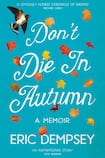
Patrick Kavanagh’s father died in autumn. “It is a fine thing to die when the leaves are falling and not when the cry of spring is in the hills,” the poet believed. But Eric Dempsey asked his parents to hold off dying during the autumn because it is the best time of year for birdwatchers to see new and exciting birds, as it is the migrating season. He jokes that in autumn the only funeral he might attend would be his own.
Dempsey, one of Ireland’s leading and most well-known bird experts (he has written a number of books on the subject), hails from the north Dublin city suburb of Finglas. He learned animal welfare early; his mother used to berate the milkman if she ever saw him mistreating his horse. From the time he was three and his mother took him to the kitchen window to watch a house sparrow feeding its young, he has been hooked on birds. The love of nature his parents instilled in him was reinforced by his first teacher, Mrs McCarthy, who inspired many other north Dublin city children to go on to be botanists and birdwatchers.
When he was eight, he got the first issue of a weekly magazine, Purnell’s Illustrated Encyclopaedia of Animal Life, which, he says, changed his life; it “was the catalyst that gave me a sense of wonder about the natural world that has never left me”. The six-volume collection still has pride of place on his shelf nearly 50 years later. The last issue of Purnell’s was followed by the first issue of The Encyclopaedia of Birds. It turned him into a fledgling birdwatcher and he had found his true passion in life.
The milestones along the way of that passion are told in various chapters, such as the first time he saw a kingfisher, which happened one time he was mitching from school in the Botanic Gardens. He left school at 16 and became a junior postman; the first things he bought himself were good binoculars and a telescope. Trips and outings followed, taking notes and making sketches, getting to know and become known in the birdwatching community.
Cape Clear had “legendary status in the lore of Irish birding” and Dempsey’s first visit there at the age of 18 is recounted in loving detail. Seeing his first subalpine warbler was seeing a “mega” (a really rare bird). “We stood in silent reverence for one of the best birds we have ever seen in our lives.”
Even if you are not mad into birds, many of the details about them are presented in such a way as to attract the interest and provoke thought. For example, ring ouzels were traditionally common in the valley of Glenmalure. “Their plaintive songs seem to reflect the vastness and remoteness of the valleys they inhabit.” Now they are gone from Wicklow and “a very rare Irish breeding species”.
In 1990, he and some fellow birders set up the Birds of Ireland News Service (BINS), a premium-rate phone service based on his parents’ home phone number, to give alerts about bird sightings. Dempsey himself ran BINS and developed the diplomatic skills of “a veteran negotiator with the UN Security Council”. He put a huge amount of work into it for more than 20 years until the arrival of texting and the internet made it no longer necessary.
A number of overseas trips are described, the most amusing being in a chapter entitled “Deliverance” (the allusion is to the film), where in a remote place in Queensland, Australia, he and a friend encountered a man of Cork descent, wielding a meat cleaver and wearing blood-stained clothes, who gave them kangaroo meat to feed kookaburras and showed them a duck-billed platypus. The altitude sickness he suffered in the Tibetan plateaus on “the roof of the world” is vividly (and frighteningly) described as he pursued a Tibetan snowcock, “a bird worth dying for” – and he almost did.
His beloved father’s terminal cancer was diagnosed in autumn and the courageous way he told his son was deeply moving. And he granted his son’s wish, holding on until late November before dying. Dempsey’s strong love of his parents features again and again.
He gave up gainful employment in 2001 and pursued birding as a career: visiting schools, giving workshops, courses and tours, and appearing on Mooney Goes Wild on radio. He has never looked back and has no regrets following a life well lived.
This is a beautifully written, warm, engaging and moving memoir, shot through with the native Dubliner’s wonderful sense of humour and natural wit (seen at its best in the hilarious chapter about the “conscientious left-wing guinea pig”).

